Overview
The Leadtek 9553 is one of the latest (and greatest) generation of Bluetooth GPS receivers designed for PDAs, Smartphones and PCs.
Almost all of the receivers have similar performance which is understandable as they are using the same core technologies. The differences mainly occur in the power sources, the antenna and the styling.
The style of the Leadtek 9553 is what really makes it stand out from the crowd, but does it back up the style with performance and staying power?
Read on and find out what we thought of this sexy little GPS receiver... (Can I call a GPS receiver sexy? I must consult Mr Freud!)
|
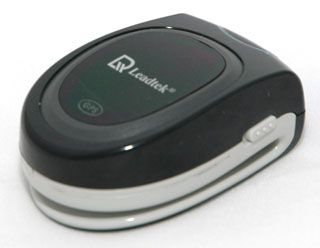 |
Whats in the box
The retail sample that I was supplied with had the following in the box:
- Leadtek 9553 SiRFstarIII Bluetooth receiver
- Car charger lead
- USB Cable for PC
- UK plug attachment
- European plug attachment
- CD Rom with software
- Small non-slip mat
|
Manufacturers Specifications
The following specifications have been taken from the Leadtek site:
| Electrical Characteristics |
| General |
| Chipset |
Sirf Star III |
| Frequency |
L1, 1575.42 MHz |
| C/A code |
1.023 MHz chip rate |
| Channels |
20 channel all-in-view tracking |
| Tracking Sensitivity |
-159dBm |
| Antenna Type |
Built-in Ceramic patch antenna (External antenna optional) |
| Accuracy |
| Position |
10 meters, 2D RMS |
| 7 meters 2D RMS, WAAS corrected |
| 1-5 meters, DGPS corrected |
| Velocity |
0.1 meters/second |
| Time |
1 microsecond synchronized to GPS time |
| Datum |
| Default |
WGS-84 |
| Other |
selectable for other Datum |
| Acquisition Rate (Open sky, stationary) |
| Reacquisition |
0.1 sec., average |
| Hot start |
1 sec., average |
| Warm start |
38 sec., average |
| Cold start |
42 sec., average |
| Dynamic Conditions |
| Altitude |
18,000 meters (60,000 feet) max. |
| Velocity |
515 meters/second (1000 knots) max. |
| Acceleration |
4g, max. |
| Jerk |
20 meters/second, max. |
| Power |
| Operational Power |
3.3VDC±10% |
| Input Power |
5VDC±10% |
| Battery Source |
rechargeable and removable Li-polymer battery with 150mA charging circuit (300mA) |
| Operational Current |
110~120mA Typical (Full power) , 60mA(Trickle power) |
| Backup Power |
3.3V |
| Operation Time Default |
5 hours under trickle power mode/ 2.5 hours continuous mode |
| Main Interface |
| Connection |
Communication with host platform via Bluetooth Serial Profile |
| Protocol messages |
NMEA-0183 output protocol |
| Baud rate |
57600 bps |
| Data bit |
8 |
| Parity |
N |
| Stop bit |
1 |
| Environmental Characteristics |
| Operating temperature range |
-20 °C to +60 °C |
| Humidity range |
5% to 95% No condensing |
| Physical Characteristics |
| Length |
2.42” (61.4 mm) |
| Width |
1.66” (42.3mm) |
| Height |
1.00” (25.4 mm) |
| Weight |
36g (without chargeable battery) |
| 44g (with chargeable battery) |
|
|
The Leadtek 9553 GPS review
The Leadtek 9553 Bluetooth GPS receiver is billed as being the smallest BT GPS. Not only is it small but it has a revolutionary new design. Gone are the boxy "coffin" style cases and in come smooth curves and some innovative design points.
The GPS pictured alongside an Orange C500 gives you a good idea of it's size. It is marginally taller than the phone, but is slightly narrower and half the length. |
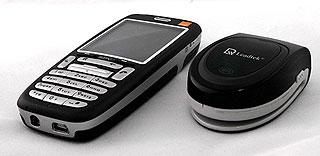
|
This does make it very small. In fact the GPS is only taller than the phone because of the molded in belt clip.
The battery is an unusual semi-circular shape, and fits into the main GPS body. The battery is rated at 300 milliamps a fraction of the capacity of some other BT GPS devices.
The picture to the right shows the battery removed from the GPS. If you look closely at the contacts on the GPS you will see that the second one from the right is not as high as the others. I have found that removing the battery can catch the contacts and bend them somewhat. |
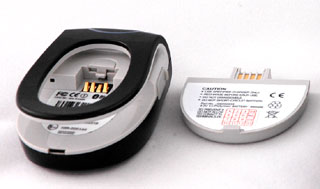 |
This should not be a problem as you would not normally remove the battery at all, but it is a potential weakness. I have tested by removing and replacing the battery over 50 times and the contact has not broken.
The GPS has a physical make/break contact style switch. This suits some people and not others. I prefer this type of switch as opposed to the press and hold soft contact type of power switch. |
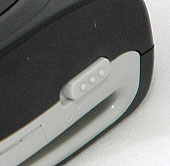 |
What it does mean is that this GPS does not have a software auto power off function when there is no Bluetooth connection. You could leave the GPS permanently powered in the car, or you could drain the battery by accidentally leaving it on.
Pictured to the right is the power connector. This is a standard USB connector which can provide power using a USB port from a PC, or through one of the supplied adapters.
Whilst the GPS is connected to power a small red led lights up the "GPS" logo under the Leadtek logo. This led will flash green when the unit is searching for satellites, and will be extinguished when a fix is acquired.
At the top of the GPS receiver you can see a semi circle. This is also an led indicator. It flashes blue when waiting to connect to a Bluetooth device, and is solid blue when the GPS has connected correctly.
The specifications mention an external antenna, but I am unable to see where that would connect.
|
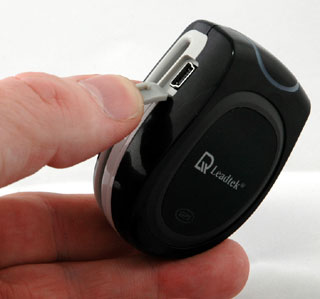 |
The Leadtek 9553 BT GPS in use
I used the Leadtek, with a number of my PDAs and also I used it with my Sony Ericsson P910. With all devices I had no problems connecting to the GPS and retaining a connection.
The SiRFstarIII chipset really is wonderful compared to earlier technologies. This GPS is able to get a fix, and an accurate one at that, in many circumstances that were impossible pre-SiRFstarIII.
I did find it marginally less sensitive than some of the other SiRFstarIII receivers, but far more so than any SiRFstarII ones. |
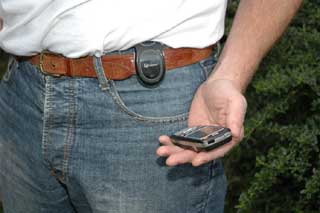 |
The SiRF software installed on the GPS appears to be version 3.0.2, this has now been superceded by version 3.1 which supports WAAS. I am not sure what software version is currently shipping.
The two images to the right show the results of some comparative tests taken at the same time. The top image shows the Leadtek 9553 positioned on the windowsill of my office, whereas the lower one is from my desk 3 metres from a window. You can click on them to see full sized images.
As you would expect the top one shows very strong signals, and the one at the bottom shows much weaker data. Interestingly at my desk I get a fix on a satellite that I don't at the window. On the other hand a satellite visible at the window is not strong enough to reach my desk.
So we have a great small device, there must be some drawbacks? Well of course there are! You cant lose all that bulk without compromising on something. And that something is power. This GPS is quoted at lasting 5 hours. In my experience it only made an average of 2 and a half hours. At first I thought this was a disaster, and to me it would be. I go out for 6-8 hours cycling or walking. Then I started thinking about it from another point of view. If you only use SatNav occasionally whilst walking in the city or somewhere, then this is an ideal device, as long as you are aware of its limitations. |
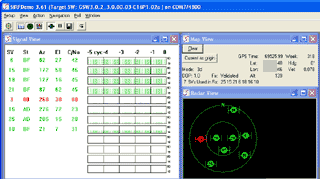 Click on image for a full sized screen in a new window Click on image for a full sized screen in a new window
GPS setup on the Windowsill
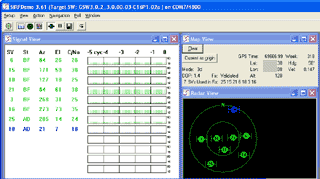 Click on image for a full sized screen in a new window Click on image for a full sized screen in a new window
GPS receiver on my desk |
I experienced one other problem during my test. I lost a battery when I unclipped the GPS from my belt. I am not quite sure how this happened as I have since tried to recreate the same scenario and have not managed to. My main problem was that I didn't notice at the time and consequently had no idea quite where to look for it. The good news is that Handtec were able to replace it so I could complete the review. |